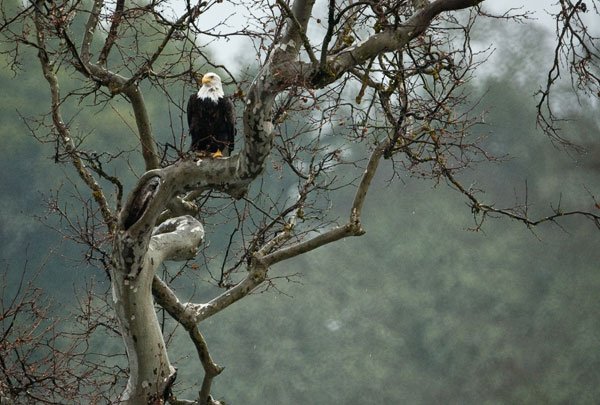A bald eagle perched stoically with his mate on the water-logged
branch of a live oak near the Chesbro Reservoir, its white head and
tail feathers contrasting sharply with the dreary backdrop of the
overcast day.
A bald eagle perched stoically with his mate on the water-logged branch of a live oak near the Chesbro Reservoir, its white head and tail feathers contrasting sharply with the dreary backdrop of the overcast day.
Thirty years ago, spotting the majestic bird of prey in Santa Clara County was practically unheard of. Today, thanks to the efforts of conservationists, about five or six pairs call local reservoirs home every year, retired Fish and Game Warden Henry Coletto said.
Bald eagles feed primarily on fish, and thus Uvas, Chesbro and Coyote reservoirs are annual favorites for the bird with the unmistakable plumage, Coletto said. Locals have even spotted the eagles in more populated areas, such as San Martin.
Once on the brink of extinction in the continental United States, the population of eagles stabilized in the 1990s and they are no longer listed as an endangered species by the U.S. Fish and Wildlife Service. In the 1970s, however, the birds were seriously threatened, remembered Dennis Taylor, an Audubon Society volunteer.
The use of DDT, a synthetic pesticide with a controversial history, caused a series of unintended consequences. The chemical made its way into the region’s waterways, building up in the fatty tissue of fish. Once the bald eagle ingested them, the DDT then interfered with eagles’ reproduction, causing the shells of their eggs to be thinner.
“The moms would crush the eggs,” Taylor explained.
Like Canadian geese, bald eagles mate for life but will take another mate if theirs is lost or dies.
Although the birds never left California, their numbers dwindled to a “frightening few,” Taylor said. “But now they’re making a pretty healthy comeback.”
With the ban on DDT in 1972 came the resurgence of the bald eagle population in the Santa Clara Valley. Now, conservationists are facing similar dwindling populations of golden eagles and California condors. While bald eagles are fish eaters, their golden counterparts feed on mammals, even if they’re already dead. Often, they’ll swoop down on the scraps of a marmot or a squirrel a rancher has shot. The lead bullets fragment and poison the animals, Taylor said.
Golden eagles and California condors are having “some rough and tough times,” Coletto said.
On their way to Canada, the bald eagles will stay about four months before heading back north, Coletto said. However, they will return, as they tend to nest in the same spot every year.
“Chesbro makes sense at this time of year,” Taylor said. “But you won’t see them anywhere in the summer at this latitude.”
By summer, bald eagles have already made their way north of the Canadian border and into Alaska, where they arrive in droves.
“We get all excited over one bald eagle,” Coletto said. “That’s nothing compared to Alaska.”
Park and reservoir visitors may spot an eagle or two during the next few weeks but should admire them from afar and not disturb the birds, Coletto said. They tend to move on once they encounter too many humans.
“Bald eagles are kind of a shy bird,” Coletto said. “They’ll fish at Chesbro for a couple days, then get pushed over to (Henry W.) Coe (State) Park. They kind of work their way around.”
But even after 38 years as a fish and game warden, Coletto said he still stops in his tracks when he spots a bald eagle.
“It’s not a common bird to see around here and when you do see them, it’s pretty exciting,” Coletto said. “They’re beautiful birds.”
To see more photos, go to www.flickr.com/photos/pauley/sets/72157623357195659/













